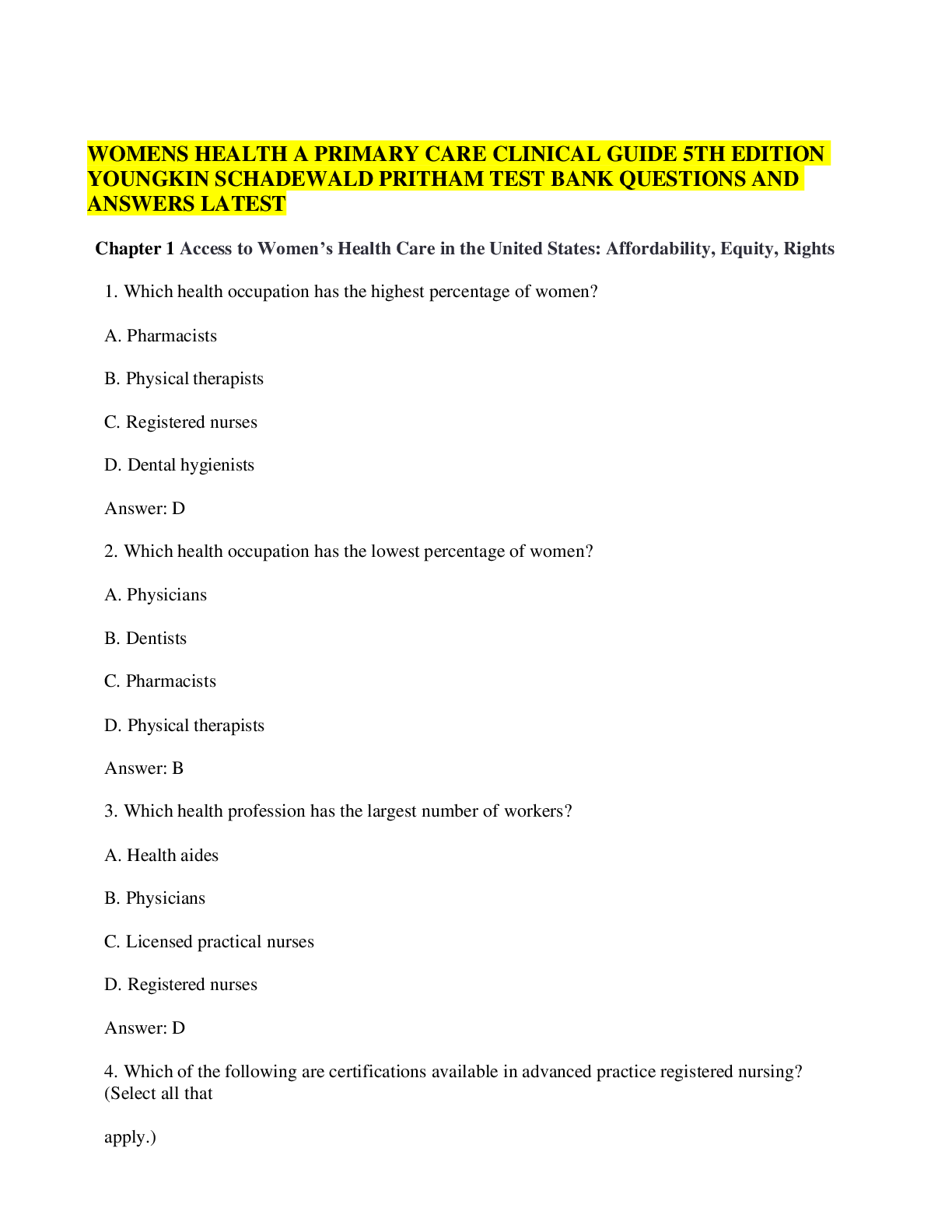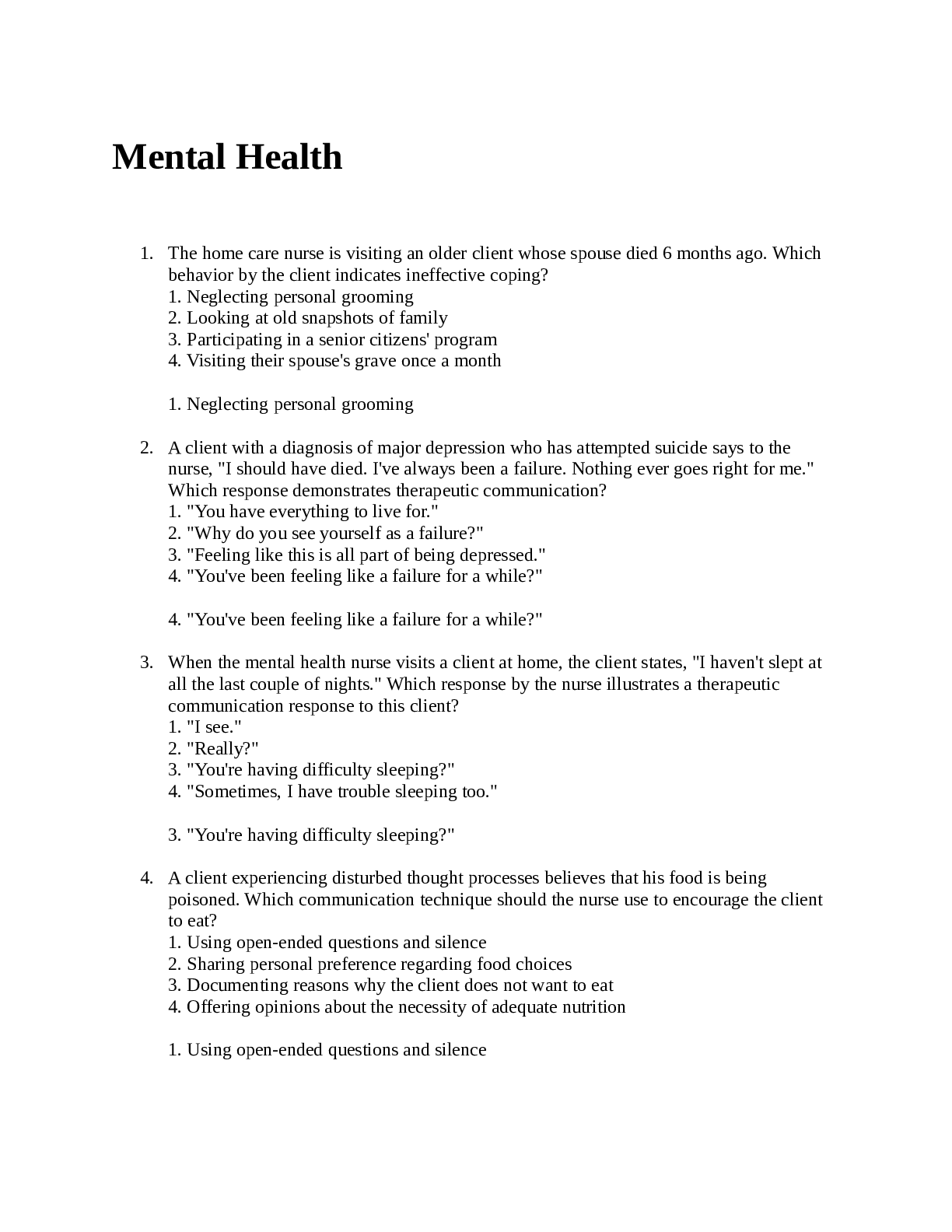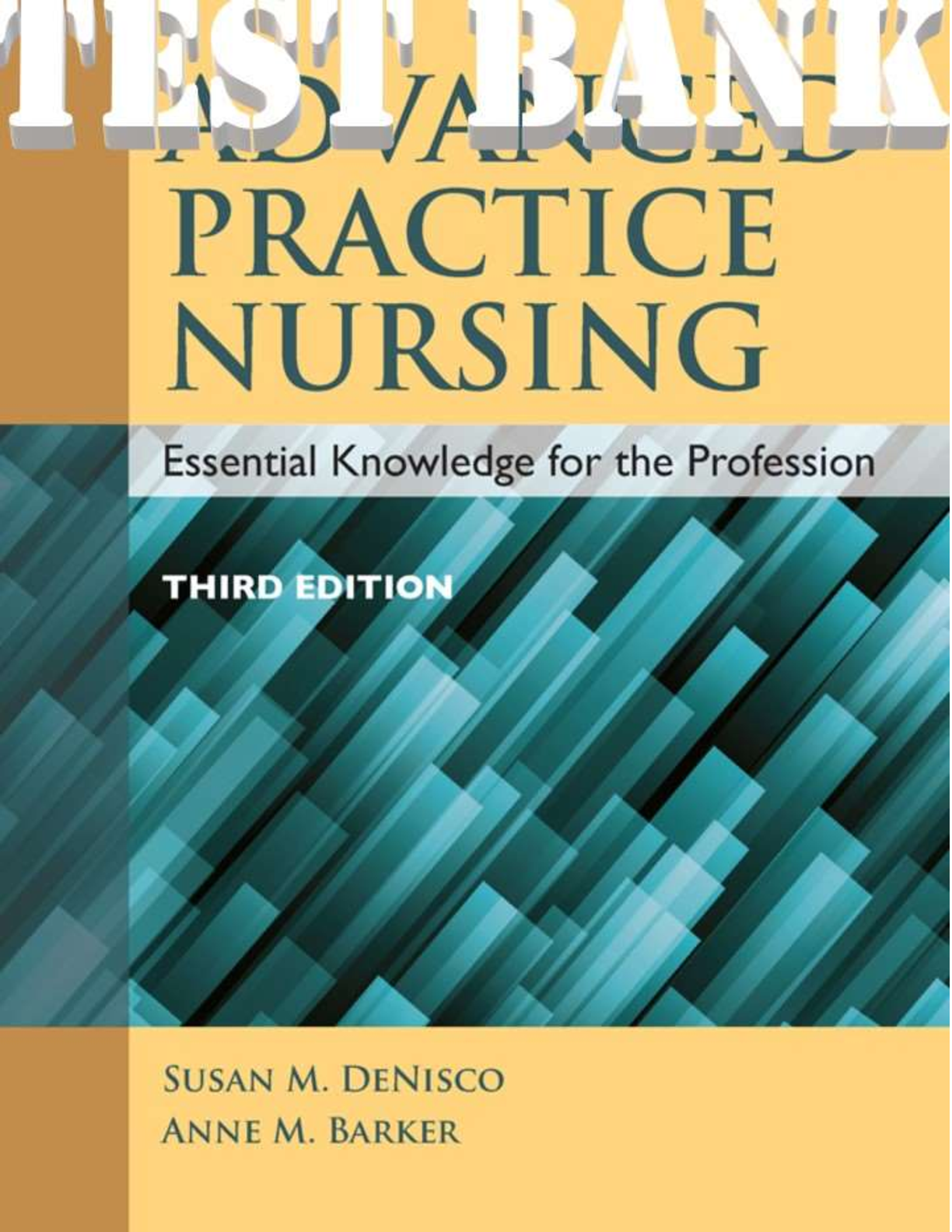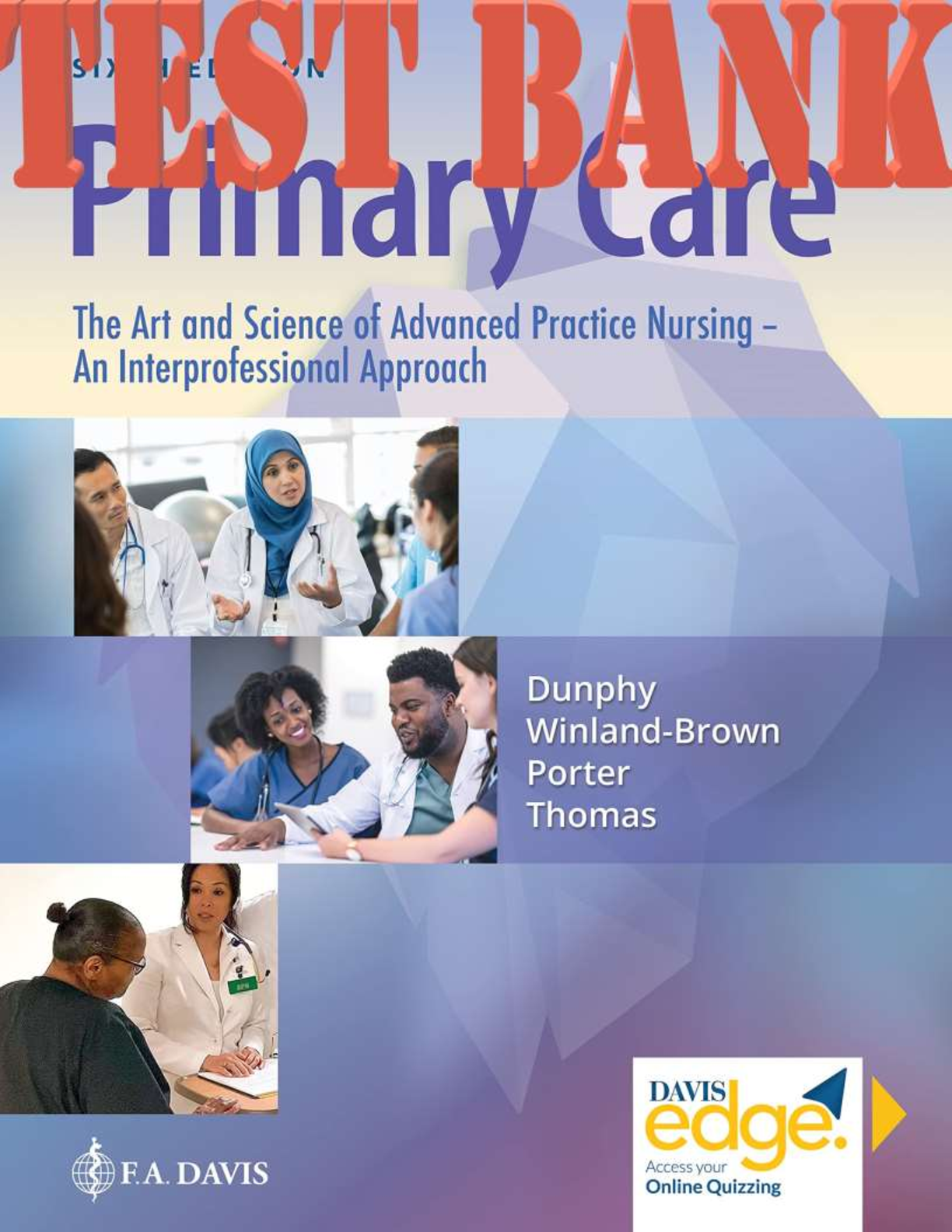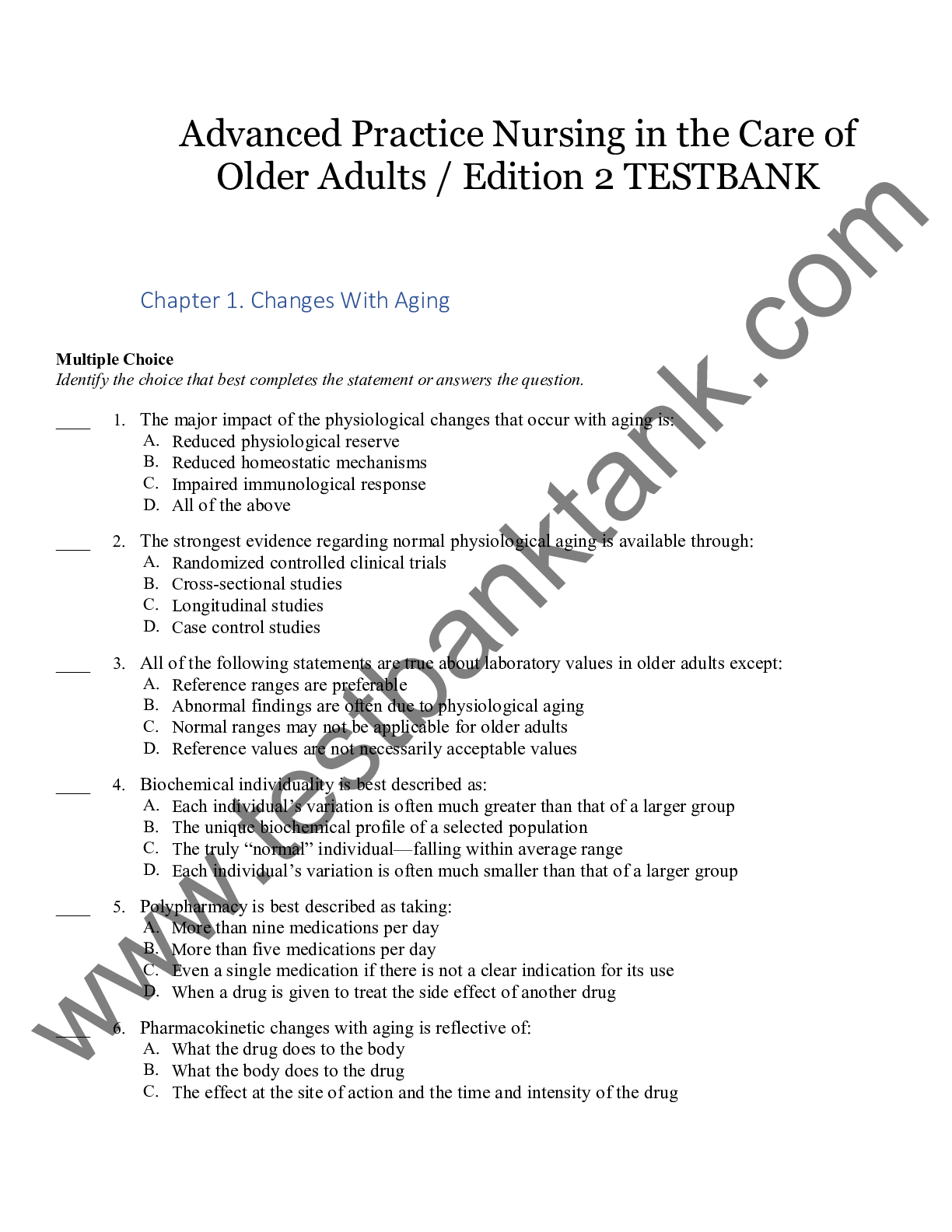*NURSING > TEST BANK > Test Bank Advanced Practice Nursing Essentials for Role Development Chapter 1 – Chapter 30. (All)
Test Bank Advanced Practice Nursing Essentials for Role Development Chapter 1 – Chapter 30.
Document Content and Description Below
Test Bank Advanced Practice Nursing Essentials for Role Development Chapter 1 – Chapter 30. CHAPTER1: ANSWERS AND RATIONALES 1. Which change represents the primary impetus for the end of the ... era of the female lay healer? 1. Perception of health promotion as an obligation 2. Development of a clinical nurse specialist position statement 3. Foundation of the American Association of Nurse-Midwives 4. Emergence of a medical establishment Page: 4 Feedback 1. . Lay healers traditionally viewed their role as being a function of their community obligations; however, the emerging medical establishment viewed healing as a commodity. The emergence of a male medical establishment represents the primary impetus for the end of the era of the female lay healer. 2. . The American Nurses Association (ANA) position statement on educational requirements for the clinical nurse specialist (CNS) was developed in 1965; the ANA’s position statement on the role of the CNS was issued in 1976. The emergence of a male medical establishment represents the primary impetus for the end of the era of the female lay healer. 3. . The American Association of Nurse-Midwives (AANM) was founded in 1928. The emergence of a male medical establishment represents the primary impetus for the end of the era of the female lay healer. 4. The emergence of a male medical establishment represents the primary impetus for the end of the era of the female lay healer. Whereas lay healers viewed their role as being a function of their community obligations, the emerging medical establishment viewed healing as a commodity. The era of the female lay healer began and ended in the 19th century. The American Association of Nurse-Midwives (AANM) was founded in 1928. The American Nurses Association (ANA) position statement on educational requirements for the clinical nurse specialist (CNS) was developed in 1965; the ANA’s position statement on the role of the CNS was issued in 1976. 2. The beginning of modern nursing is traditionally considered to have begun with which event? 1. Establishment of the first school of nursing 2. Incorporation of midwifery by the lay healer 3. Establishment of the Frontier Nursing Service (FNS) 4. Creation of the American Association of Nurse-Midwives (AANM) Pages: 4–5 Feedback 1. Traditionally, modern nursing is considered to have begun in 1873, when the first three U.S. training schools for nurses opened. The role of the lay healer as a midwife is documented to have occurred in the 19th century, before the establishment of schools of nursing. The Frontier Nursing Service (FNS), which provided nurse-midwifery services, was established in 1925. In 1928, the Kentucky State Association of Midwives, which was an outgrowth of the FNS, became the American Association of Nurse-Midwives (AANM). 2. . The role of the lay healer as a midwife is documented to have occurred in the 19th century, before the establishment of schools of nursing. Traditionally, modern nursing is considered to have begun in 1873, when the first three U.S. training schools for nurses opened. 3. . The Frontier Nursing Service (FNS), which provided nurse- midwifery services, was established in 1925. Traditionally, modern nursing is considered to have begun in 1873, when the first three U.S. training schools for nurses opened. 4. . In 1928, the Kentucky State Association of Midwives, which was an outgrowth of the FNS, became the American Association of Nurse- Midwives (AANM). Modern nursing is considered to have begun in 1873, at which time the first three U.S. training schools for nurses opened. 3. In 1910, which factors most significantly influenced the midwifery profession? Select all that apply. 1. Strict licensing requirements 2. Negative public perception 3. Dedicated funding for training 4. Poor maternal-child outcomes 5. Mandatory professional supervision Pages: 6–7 Feedback 1. . In 1910, the midwifery profession was significantly influenced by poor maternal-child outcomes and a public perception as unprofessional. Though legislation ultimately was passed to tighten requirements related to licensing and supervision of midwives, in the early 20th century, midwives were largely unregulated and generally perceived as unprofessional. 2. In 1910, the midwifery profession was significantly influenced by poor maternal-child outcomes and a public perception as unprofessional. At that time, approximately 50% of all U.S. births were reportedly attended by midwives. However, especially with regard to perinatal health indicators, the national population’s general health was poor. Unfavorable outcomes among both mothers and infants were attributed to midwives who, at that time, were largely unregulated and generally perceived as unprofessional. Poor maternal-child outcomes, negative perceptions of midwives, obstetricians’ targeted efforts to take control of the birthing process, and a movement away from home births prompted major changes. Legislation was passed to tighten requirements related to licensing and supervision of midwives. One aim of the Sheppard-Towner Maternity and Infancy Act involved allotting funds to train public health nurses in midwifery; however, the bill lapsed in 1929. 3. . Goals of the Sheppard-Towner Maternity and Infancy Act included allocating funds to train public health nurses in midwifery, but the bill lapsed in 1929. In 1910, poor maternal-child outcomes and a public perception as unprofessional significantly influenced the midwifery profession. 4. In 1910, the midwifery profession was significantly influenced by poor maternal-child outcomes and a public perception as unprofessional. At that time, approximately 50% of all U.S. births were reportedly attended by midwives. However, especially with regard to perinatal health indicators, the national population’s general health was poor. Unfavorable outcomes among both mothers and infants were attributed to midwives who, at that time, were largely unregulated and generally perceived as unprofessional. Poor maternal-child outcomes, negative perceptions of midwives, obstetricians’ targeted efforts to take control of the birthing process, and a movement away from home births prompted major changes. Legislation was passed to tighten requirements related to licensing and supervision of midwives. One aim of the Sheppard-Towner Maternity and Infancy Act involved allotting funds to train public health nurses in midwifery; however, the bill lapsed in 1929. 5. . In 1910, the midwifery profession was largely unregulated. Factors that influenced the profession included poor maternal-child outcomes and a public perception as unprofessional. 4. Which advanced practice nursing role is unique in that the practitioners view their role as comprising a combination of two distinct disciplines? 1. Nurse practitioner 2. Certified registered nurse anesthetist 3. Clinical nurse specialist 4. Certified nurse-midwife Page: 9 Feedback 1. . The role of the certified nurse-midwife (CNM) is unique in that the CNM views the practice role as combining two disciplines: nursing and midwifery. 2. . The role of the certified nurse-midwife (CNM) is unique in that the CNM views the practice role as combining two disciplines: nursing and midwifery. 3. . The role of the certified nurse-midwife (CNM) is unique in that the CNM views the practice role as combining two disciplines: nursing and midwifery. 4. The role of the certified nurse-midwife (CNM) is unique in that the CNM views the practice role as combining two disciplines: nursing and midwifery. 5. In the 19th century, which factors led to the administration of anesthesia by nurses? Select all that apply. 1. Surgeon entitlement to collecting anesthesia fees 2. Collaborative practice between physician-anesthetists and nurses 3. Lack of recognition of anesthesiology as a medical specialty 4. Opposition to anesthesia administration by physicians 5. Formation of a national organization by nurse anesthetists , 3 Pages: 10–11 Feedback 1. In the 19th century, anesthesia was in its early stages. Because of a lack of recognition as a medical specialty and the surgeon’s entitlement to collecting anesthesia fees, other physicians had little to no interest in anesthesia administration. However, physicians were not opposed to administering anesthesia; rather, anesthesia was viewed as a means by which to transform surgery into a scientific modality for treating health alterations. Collaboration between physicians and nurses did not contribute to administration of anesthesia by nurses; contentiousness is a hallmark of the relationship between nurse anesthetists and anesthesiologists even in the present day. In the 19th century, no national organization of nurse anesthetists yet existed. The National Association of Nurse Anesthetists, which was renamed the American Association of Nurse Anesthetists (AANA), was founded in 1931. 2. . With the introduction of anesthesia, collaboration between physicians and nurses did not contribute to administration of anesthesia by nurses. By contrast, contentiousness is a hallmark of the relationship between nurse anesthetists and anesthesiologists even in the present day. In the 19th century, anesthesia was in its early stages. Administration of anesthesia by nurses occurred primarily because of anesthesiology’s lack of recognition as a medical specialty and the surgeon’s entitlement to collecting anesthesia fees. 3. In the 19th century, anesthesia was in its early stages. Because of a lack of recognition as a medical specialty and the surgeon’s entitlement to collecting anesthesia fees, other physicians had little to no interest in anesthesia administration. However, physicians were not opposed to administering anesthesia; rather, anesthesia was viewed as a means by which to transform surgery into a scientific approach to treating with health alterations. Collaboration between physicians and nurses did not contribute to administration of anesthesia by nurses; contentiousness is a hallmark of the relationship between nurse anesthetists and anesthesiologists even in the present day. In the 19th century, no national organization of nurse anesthetists yet existed. The National Association of Nurse Anesthetists, which was renamed the American Association of Nurse Anesthetists (AANA), was founded in 1931. 4. . In the 19th century, anesthesia was in its early stages. Physicians were in favor of the administration of anesthesia, viewing this advancement as a means by which to transform surgery into a scientific modality for treating health alterations. Because of a lack of recognition as a medical specialty and the surgeon’s entitlement to collecting anesthesia fees, other physicians had little to no interest in anesthesia administration. As such, the administration of anesthesia was assigned to nurses. 5. . The National Association of Nurse Anesthetists, which was renamed the American Association of Nurse Anesthetists (AANA), was founded in 1931. In the 19th century, anesthesia was in its early stages. Because of a lack of recognition as a medical specialty and the surgeon’s entitlement to collecting anesthesia fees, other physicians had little to no interest in anesthesia administration. Thus, anesthesia administration was performed by nurses. 6. Which factor contributed to expansion of the role of the clinical nurse specialist (CNS) during the 1960s? 1. Increased numbers of practicing physicians 2. Tightening of female role definitions 3. Return of nurses from military conflict 4. Lack of medical specialization Page: 17 Feedback 1. . During the 1960s, a shortage of physicians occurred. The role of the CNS was expanded in part because of the return of nurses from the Vietnam War. Nurse veterans searched for opportunities to increase their knowledge and skills, and practiced in advanced roles as well as nontraditional specialties (such as anesthesia and trauma or anesthesia). 2. . During the 1960s, role definitions for women became less restrictive. The role of the CNS was expanded in part because of the return of nurses from the Vietnam War. Nurse veterans searched for opportunities to increase their knowledge and skills, and practiced in advanced roles as well as nontraditional specialties (such as anesthesia and trauma or anesthesia). 3. Expansion of the CNS role during the 1960s occurred in part because of the return of nurse veterans from the Vietnam War who sought to increase their knowledge and skills, and to work in advanced roles and nontraditional fields, such as anesthesia and trauma. 4. . In the 1960s, medical specialization was prevalent, and the need for competent nurses who were proficient at caring for patients with complex health needs increased. Thus, the CNS role expanded. The role of the CNS also expanded because of the return of nurses from the Vietnam War. Many of these nurse veterans searched for opportunities to increase their knowledge and skills, and practiced in advanced roles as well as nontraditional specialties (such as anesthesia and trauma or anesthesia). 7. Differentiation between the role of the clinical nurse specialist (CNS) and the nurse practitioner (NP) is primarily based on which premise? 1. Designation as an advanced practice nurse 2. Diagnosis of patient health conditions 3. Nature of practice setting environments 4. Authority to prescribe medications Pages: 20–21 Feedback 1. . Both the clinical nurse specialist (CNS) and the nurse practitioner (NP) are designated as advanced practice nurses (APNs). A primary differentiation between the roles of CNS and NP centers on the nature of the practice setting. Although the CNS most often practices in a secondary or tertiary care setting, the NP often practices in a primary care setting. 2. . Both the clinical nurse specialist (CNS) and the nurse practitioner (NP) are prepared to diagnose patient health alterations. A primary differentiation between the roles of CNS and NP centers on the nature of the practice setting. Although the CNS most often practices in a secondary or tertiary care setting, the NP often practices in a primary care setting. 3. A primary differentiation between the roles of clinical nurse specialist (CNS) and nurse practitioner (NP) centers on the nature of the practice setting. Although the CNS most often practices in a secondary or tertiary care setting, the NP often practices in a primary care setting. Both the CNS and the NP are designated as advanced practice nurses (APNs), educationally prepared to diagnose patient health alterations, and eligible to apply for prescriptive authority. 4. . Both the clinical nurse specialist (CNS) and the nurse practitioner (NP) are eligible to apply for authority to prescribe medications. A primary differentiation between the roles of CNS and NP centers on the nature of the practice setting. Although the CNS most often practices in a secondary or tertiary care setting, the NP often practices in a primary care setting. 8. The National Council of State Boards of Nursing’s Consensus Model for Advanced Practice Registered Nurse (APRN) Regulation prompted gains related to which aspects of the role and function of the nurse practitioner (NP)? Select all that apply. 1. Legal authority 2. Reimbursement 3. Consumer recognition 4. Prescriptive privilege 5. Autonomy , 2, 4 Page: 29 Feedback 1. The 2008 adoption of the Consensus Model for Advanced Practice Registered Nurse (APRN) Regulation by the National Council of State Boards of Nursing prompted gains related to several aspects of the role and function of the nurse practitioner (NP), including legal authority, reimbursement mechanisms in the United States, and prescriptive privilege. At present, NPs still face challenges related to autonomy, as well as consumer recognition in health care. 2. The 2008 adoption of the Consensus Model for Advanced Practice Registered Nurse (APRN) Regulation by the National Council of State Boards of Nursing prompted gains related to several aspects of the role and function of the nurse practitioner (NP), including legal authority, reimbursement mechanisms in the United States, and prescriptive privilege. At present, NPs still face challenges related to autonomy, as well as consumer recognition in health care. 3. . At present, nurse practitioners (NPs) still face challenges related to consumer recognition in health care. The 2008 adoption of the Consensus Model for Advanced Practice Registered Nurse (APRN) Regulation by the National Council of State Boards of Nursing prompted gains related to several aspects of the role and function of the NP, including legal authority, reimbursement mechanisms in the United States, and prescriptive privilege. 4. Adoption of the Consensus Model for Advanced Practice Registered Nurse (APRN) Regulation in 2008 by the National Council of State Boards of Nursing prompted gains related to several aspects of the role and function of the nurse practitioner (NP), including legal authority, reimbursement mechanisms in the United States, and prescriptive privilege. At present, NPs still face challenges related to autonomy, as well as consumer recognition in health care. 5. . At present, nurse practitioners (NPs) still face challenges related to autonomy. The 2008 adoption of the Consensus Model for Advanced Practice Registered Nurse (APRN) Regulation by the National Council of State Boards of Nursing prompted gains related to several aspects of the role and function of the NP, including legal authority, reimbursement mechanisms in the United States, and prescriptive privilege. At present, NPs still face challenges related to autonomy, as well as consumer recognition in health care. 9. The doctor of nursing practice (DNP) degree was developed to support the achievement of which goal related to advanced practice nursing education? 1. Eliminating master’s degree programs 2. Promoting excellence in clinical practice 3. Replacing doctor of philosophy programs 4. Emphasizing the generation of nursing research Pages: 31, 33 Feedback 1. . Rather than seeking to eliminate master’s degree programs designed to prepare advanced practice registered nurses (APRNs), current legislation exists to preserve such programs. The doctor of nursing practice (DNP) is focused on preparing the nurse clinician to demonstrate excellence in nursing practice. 2. The doctor of nursing practice (DNP) is not intended to replace the doctor of philosophy (PhD). Whereas the PhD emphasizes research, the DNP is focused on preparing the nurse clinician to demonstrate excellence in nursing practice. Current legislative efforts related to nursing education do not include elimination of master’s degree programs for advanced practice registered nurses (APRNs). Rather, current legislation exists to preserve existing master’s degree programs designed to prepare APRNs. 3. . The doctor of nursing practice (DNP) is not intended to replace the doctor of philosophy (PhD). The DNP is focused on preparing the nurse clinician to demonstrate excellence in nursing practice. 4. . Unlike the doctor of philosophy (PhD), which emphasizes research, the doctor of nursing practice (DNP) is focused on preparing the nurse clinician to demonstrate excellence in nursing practice. 10. Among national nursing leaders, which argument serves as a basis for opposition to the requirement that advanced practice nurses (APNs) earn a doctor of nursing practice (DNP) degree? 1. Greater professionalization is needed among advanced practice nurses. 2. The number of graduate nursing programs should be limited. 3. Advanced practice nursing certification should not require a doctoral degree. 4. The need for care providers should be prioritized. Page: 33 Feedback 1. . National nursing leaders have opposed a proposition to require completion of a doctor of nursing practice (DNP) degree by advanced practice nurses (APNs) who seek certification based on a perception that the need for care providers should be prioritized above professionalization of advanced practice registered nurses (APRNs) by way of completing a DNP program. 2. . National nursing leaders have not sought to limit graduate nursing education programs for advanced practice registered nurses (APRNs). The basis for opposition among national nursing leaders related to requiring advanced practice nurses (APNs) to complete a doctor of nursing practice (DNP) degree centers on the perception that the need for care providers takes precedence over professionalization of APRNs by way of completing a DNP program. 3. . National nursing leaders have not sought to require advanced practice nurses (APNs) to complete a doctor of philosophy (PhD) degree. Rather, national nursing leaders have opposed a mandate that would require completion of a doctor of nursing practice (DNP) degree before seeking certification as an advanced practice registered nurse (APRN) based on a perception that the need for care providers should be prioritized over professionalization of APRNs. 4. National nursing leaders have opposed a mandate that would require completion of a doctor of nursing practice (DNP) degree before seeking certification as an advanced practice registered nurse (APRN) based on a perception that the need for care providers should be prioritized over professionalization of APRNs. National nursing leaders have neither sought to limit graduate nursing education programs for APRNs nor recommended that advanced practice nurses (APNs) be required to complete a doctor of philosophy (PhD) degree. Chapter 2: Emerging Roles of the Advanced Practice Nurse ANSWERS AND RATIONALES 1. Entry into which advanced practice nursing specialty will require a doctoral degree by 2022? 1. Clinical nurse specialist (CNS) 2. Certified registered nurse anesthetist (CRNA) 3. Nurse practitioner (NP) 4. Certified nurse-midwife (CNM) Page: 5 Feedback 1. . Clinical nurse specialists (CNSs) are not required to complete a doctoral degree. However, the American Association of Nurse Anesthetists (AANA) has set forth a mandate requiring all graduates to complete a doctoral degree. Beginning in 2022, a doctorate will be the minimum requirement to enter practice as a certified registered nurse anesthetist (CRNA) (AANA, 2016). 2. Beginning in 2022, the American Association of Nurse Anesthetists (AANA) will require a doctoral degree as a minimum requirement to enter practice as a certified registered nurse anesthetist (CRNA) (AANA, 2016). 3. . Nurse practitioners (NPs) are not currently required to complete a doctoral degree. Presently, only the American Association of Nurse Anesthetists (AANA) has set forth a mandate requiring all graduates to complete a doctoral degree. Beginning in 2022, a doctorate will be the minimum requirement to enter practice as a certified registered nurse anesthetist (CRNA) (AANA, 2016). 4. . At present, certified nurse-midwives (CNMs) are not required to obtain a doctoral degree. Only the American Association of Nurse Anesthetists (AANA) has set forth a mandate requiring all graduates to complete a doctoral degree. Beginning in 2022, a doctorate will be the minimum requirement to enter practice as a certified registered nurse anesthetist (CRNA) (AANA, 2016). 2. According to the Consensus Model for APRN Regulation, advanced practice nursing should abide by which recommendation? 1. Emphasizing state-based regulation of advanced practice nursing standards 2. Ensuring regulation of advanced practice registered nurses (APRNs) as a unified, collective group 3. Preparing clinical nurse specialists (CNSs) to function primarily in acute care 4. Changing the population focus of adult nurse practitioners to adult gerontology Pages: 6, 20 Feedback 1. . The Consensus Model for APRN Regulation: Licensure, Accreditation, Certification and Education was developed by the APRN Consensus Work Group and the National Council of State Boards of Nursing (Consensus Model, 2008). Rather than emphasizing state-based regulation of advanced practice nursing, general goals of the Consensus Model include promoting consistency of advanced practice nursing standards to increase the potential for interstate licensure reciprocity. The Consensus Model recommends shifting the population focus of adult nurse practitioners (NPs) to adult gerontology. 2. . The Consensus Model for APRN Regulation: Licensure, Accreditation, Certification and Education was developed by the APRN Consensus Work Group and the National Council of State Boards of Nursing (Consensus Model, 2008). Instead of ensuring regulation of advanced practice registered nurses (APRNs) as a collective group, the Consensus Model recommends regulation of APRNs in one of four accepted roles. Recommendations also include shifting the population focus of adult nurse practitioners (NPs) to adult gerontology. 3. . The Consensus Model for APRN Regulation: Licensure, Accreditation, Certification and Education was developed by the APRN Consensus Work Group and the National Council of State Boards of Nursing (Consensus Model, 2008). Based on the Consensus Model, the practice of clinical nurse specialist (CNS) practices occurs across both acute and primary care settings. The Consensus Model also recommends shifting the population focus of adult nurse practitioners (NPs) to adult gerontology. 4. The Consensus Model for APRN Regulation: Licensure, Accreditation, Certification and Education was developed by the APRN Consensus Work Group and the National Council of State Boards of Nursing (Consensus Model, 2008). Per the Consensus Model, the population focus of adult nurse practitioners (NPs) has shifted to adult gerontology. As opposed to emphasizing state-based regulation of advanced practice nursing, broad goals of the Consensus Model include developing more consistent standards for advanced practice nurses (APNs) that promote eligibility for interstate licensure reciprocity. Instead of ensuring regulation of advanced practice registered nurses (APRNs) as a collective group, the Consensus Model recommends regulation of APRNs in one of four accepted roles. The Consensus Model describes the practice of clinical nurse specialists (CNSs) as including both acute and primary care settings. 3. The relationship to which aspect of the function of the clinical nurse specialist (CNS) shows the greatest need for research? 1. Patient satisfaction 2. Care outcomes 3. Income generation 4. Role adaptability Pages: 8, 10 Feedback 1. . Research has identified a correlation between clinical nurse specialist (CNS)-patient interaction and patient satisfaction. Further research is needed to examine the relationship between utilization of the CNS and income generation. 2. . Existing research studies have identified a correlation between clinical nurse specialist (CNS)-patient interaction and favorable patient care outcomes. Additional research is needed to examine the relationship between utilization of the CNS and income generation. 3. Additional research is needed to examine the relationship between utilization of the clinical nurse specialist (CNS) and income generation. Role adaptability is a central feature of the CNS. Research has identified a correlation between CNS-patient interaction and favorable patient care outcomes, as well as patient satisfaction. 4. . Role adaptability, which is a primary characteristic of the clinical nurse specialist (CNS), is regarded as contributing to role ambiguity for this advanced practice role. Available research is limited related to the economic impact of the CNS, including income generation. 4. For nurse practitioners (NPs), which issue represents a current barrier to autonomy? 1. Restrictions on reimbursement for services 2. Absence of state-based prescriptive authority 3. Limited ability to serve in acute care settings 4. Lack of authority to manage medical problems Pages: 12, 15 Feedback 1. One barrier to autonomy for nurse practitioners (NPs) stems from restrictions on reimbursement for services. Among advanced practice nurses (APRNs), NPs comprise the largest group. All 50 states, as well as the District of Columbia, grant prescriptive privileges to qualified NPs (Phillips, 2016). NPs serve in primary and acute care settings. Assessment and management of patients related to medical and nursing problems is within the NP’s scope of practice. 2. . All 50 states, as well as the District of Columbia, grant prescriptive privileges to qualified NPs (Phillips, 2016). For NPs, barriers to autonomy include restrictions on reimbursement for services. 3. . Nurse practitioners (NPs) serve in both primary and acute care settings. Barriers to autonomy for NPs include restrictions on reimbursement for services. [Show More]
Last updated: 1 year ago
Preview 1 out of pages
Instant download

Buy this document to get the full access instantly
Instant Download Access after purchase
Add to cartInstant download
Reviews( 0 )
Document information
Connected school, study & course
About the document
Uploaded On
Nov 07, 2022
Number of pages
Written in
Additional information
This document has been written for:
Uploaded
Nov 07, 2022
Downloads
0
Views
3



